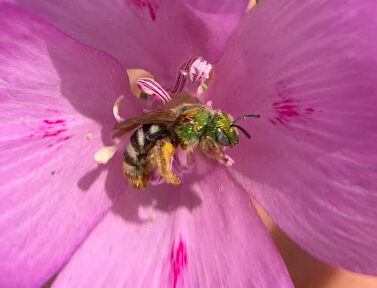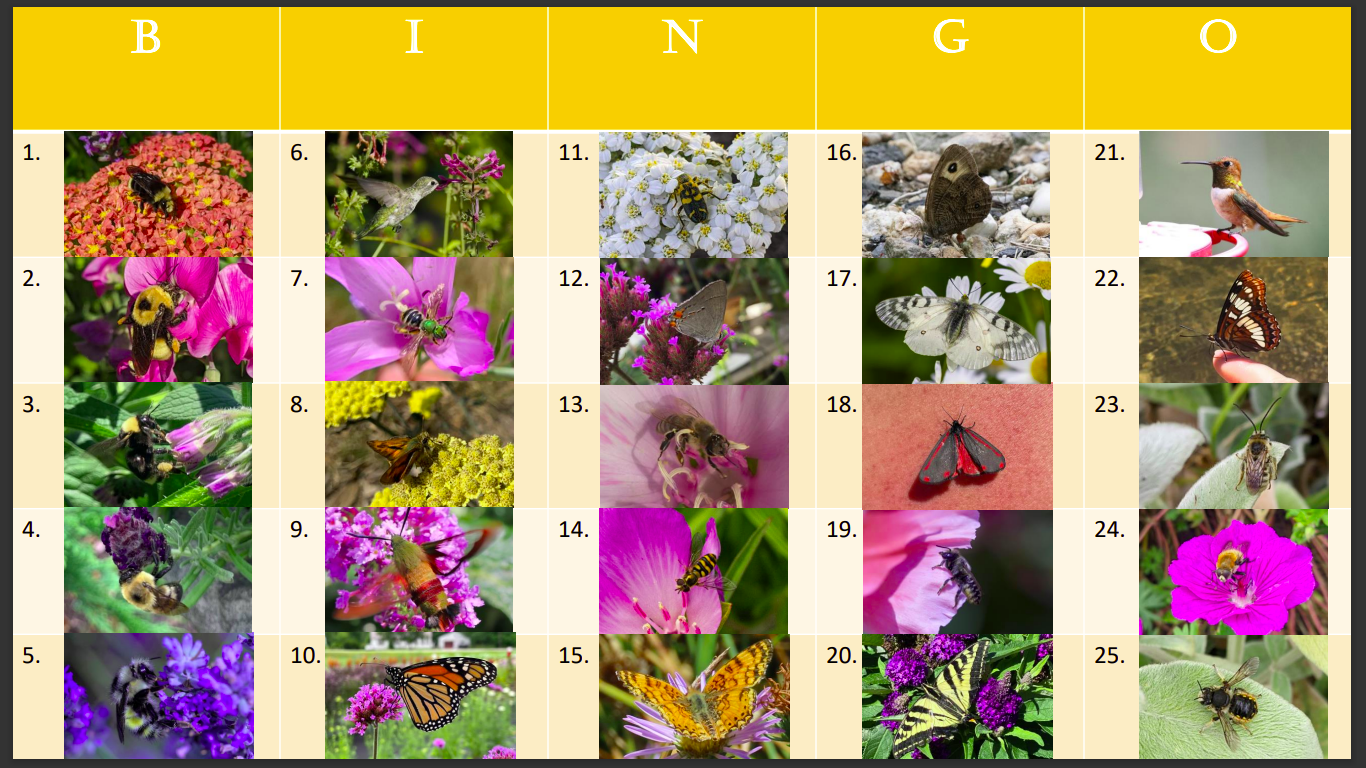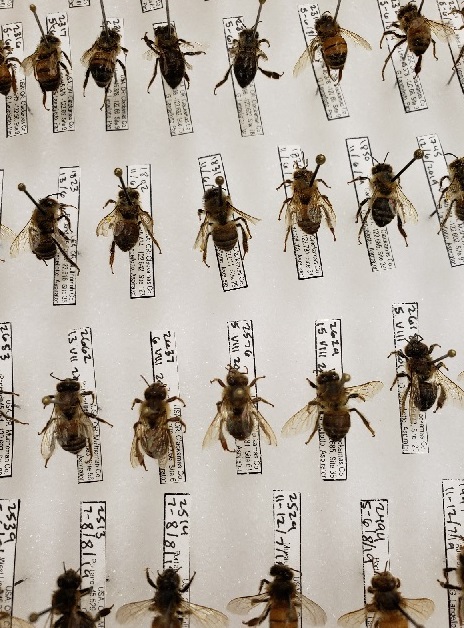
For my dissertation research, I am studying which native Willamette Valley wildflowers are most visited by pollinators and natural enemies for use in home gardens and urban landscaping. I’ve previously shared preliminary results from my field study on our blog, namely pollinator abundance and richness. For a refresher, here are summaries from 2017, 2018, and 2019.
Initial survey
Determining which of these flowers are most attractive to insects is only half of the equation — I also want flowers that are attractive to gardeners. To investigate this I developed two surveys — thanks to anyone reading who took them! The first simply asked gardeners to rank the aesthetic appeal of my study plants, as well as how likely they would be to utilize them in their home gardens. This allowed me to get a baseline understanding of how appealing these flowers are for use in home gardens and landscaping.
As you can see in the figure below, many of the plants most visited by bees (highlighted in orange) were the least attractive to gardeners (Fig. 1), while plants gardeners liked the most (e.g. Iris, Columbine) were hardly visited by bees. However, its notable that many of these native wildflowers ranked around a four on a 1-5 scale, showing that these flowers do have a high potential appeal for use in landscaping!
Figure 1: Gardener ranked aesthetic appeal of study flowers on a scale of 1-5. Orange bars note plants that were consistently highly visited pollinator plants. N=587
Follow-up survey
The follow-up survey consisted of a subset of ten flowers most visited by bees, and again asked respondents to rank the aesthetic appeal and likelihood of planting for each of these flower species. Then, they were shown facts about and images of bees that visit each flower species, and asked whether they viewed each plant species more favorably, less favorably, or the same. Finally, they were asked to re-rank how attractive they found the flower species and how likely they would be to use the species in their garden, both on a scale of 1-5.
Gardener acceptance
This second survey showed a remarkable increase in gardener acceptance of pollinator friendly native plants after being educated on plant-pollinator associations. Over 80% of respondents stated that they viewed Clarkia amoena as more attractive after gain, and over 60% of respondents viewed Phacelia heterophylla, Madia elegans, and Gilia capitata as more attractive (Fig. 2).
Figure 2: Percent of respondents viewing flower species as more attractive after learning about pollinator associations. N=184.
Likelihood of planting
After learning about the benefits these flowers provide to pollinators, gardeners were also more likely to plant all ten flower species (Fig. 3). Notably, they were 40% more likely to plant Phacelia heterophylla, (a species that ranked as the least aesthetically appealing overall in the first survey). As a whole, they were also over 20% more likely to plant Solidago canadensis, Clarkia amoena. Similar increases were also observed in likelihood of planting Oreganum vulgare and Nepeta cataria. Many of the plants that showed a smaller percent change are species that started out with a higher aesthetic appeal (e.g. Gillia capitata, Lavendula intermedia, Aster subspicatus), meaning gardeners were already very likely to include these plants in their home garden before learning about the ecological benefits they provide.
Figure 3: Percent change in respondent’s likelihood of planting each top pollinator flower after learning about the pollinators associated with each. N=184
Ecological beauty
What does this all mean? This suggests that although native plants are frequently denounced as being less attractive than showy garden species, many home gardeners are still willing to use native flowers in their landscaping. Additionally, this lends credence to the concept of “ecological beauty” – that many gardeners are willing to utilize plants that will increase the habitat value and wildlife diversity in their yards.






14 Comments
Add Yours →I would love to have some seeds to plant in my garden for the bees😍
Some of the plants can be very difficult to find in retail nurseries. Aaron wrote a story about it for the Digger (http://www.diggermagazine.com/native-plant-production-and-marketing/). The Oregon Flora Project maintains a list of native plant nurseries in Oregon (http://oregonflora.org/gardening.php). This is what we started with, to find our native plant starts, bulbs, and seeds. But, even with the list, it was difficult to assemble our study plants.
I’ve purchased many of these plants from https://willamettewildlings.com
Now that I am aware of these plants – I want to grow them in my garden. Thank you for this study. Our pollinators are part of the Climate issue. So important!
Two local sources for native plants:
http://www.willamettegardens.com/
https://www.bentonswcd.org/programs/plant-sale/
Thanks. I appreciate the information on sources of seeds and plants. It would be even more helpful if common names were also supplied. I’m imagining a nice little brochure with photos, common names, sources, and requirements for each plant. I’d even like another study on potential companions or replacements for natives? For example, borage (Borago officinalis), not native, but bees like it a lot?
Thank you. We’re working on it. What you describe will be chapter 5 of Aaron’s dissertation.
We will include common names, if they exist, but the Latin names are also important. For example, Phacelia heterophylla (highly attractive to bees in our study) is commonly known as Phacelia – but so are many other species in the genus, including Phacelia tanacetifolia, which is invasive in some parts of Oregon). Many of the wildflowers that we tested have common names that are the same as the genus name. Thus, the common name could point you to one of many different species, including some that we would not want to recommend to gardeners.
We’ll be sure to post when we have the recommended plants for Gardeners (written for a general audience) ready to share.
Hi Jane, thanks for your comment. Once this study is complete, one of our final products will be suggested pollinator planting lists with common and scientific names, local sources, bloom timing etc. Stay tuned!
That’s a great suggestion – a publication with information on native replacements for popular garden species would be really useful to put together.
Native plants do not require fertilizers and require fewer pesticides than lawns.
It was interesting thanks
Native plants are best fed natural fertilizers from animal waste
Now that I am aware of these plants – I want to grow them in my garden. Thank you for this study. Our pollinators are part of the Climate issue. So important!
thank you for sharing
You provided excellent information on the botany and ecology of horticulture.
Thankful